A wide racked, deep-forked mule deer buck climbed the face of a far ridge, almost to the top and gone. My friend, an expert shot with any kind of weapon, lay prone behind his rifle, scope trained on the buck as it climbed.
“Range?” The word was terse and unembellished with superfluous verbiage. Leaning away from my spotting scope I steadied my rangefinder on the buck.
“Nine ninety-three”. I said. “No wind.”
Back in the spotting scope, I watched as the buck halted for a breather. Seconds crawled by with tortoise-like velocity as I waited for the vapor trail. Then there it was, preceded a millisecond by the boom. Arcing high above the buck’s back the trace curved steadily downward. “Just a hair high”, I thought to myself, and the poof of dust erupting from just beyond the buck’s back proved me right.
“Right over his back”. I said. A second cartridge had been slammed home in less time than it takes to tell about it, the shooter already settling the crosshairs for a follow-up shot. I stayed in the spotting scope as the buck took a couple startled jumps forward and stopped. Then there was the second trace, and before it reached the buck I knew he was dead. Dropping at the impact, the buck kicked a couple times, slid down the slope a bit, and lay still.
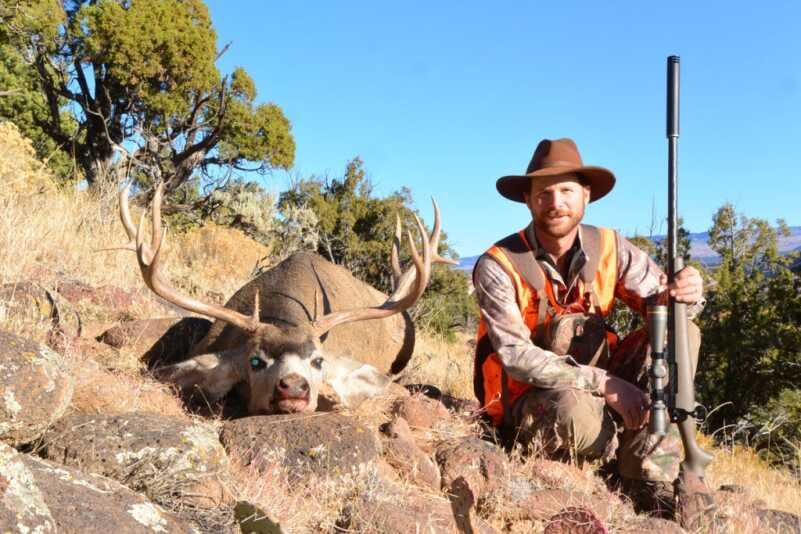
The author with a great mule deer buck, taken with a Proof Research rifle chambered in 280 Ackley Improved.
Hunting at long range is an increasingly popular sport. Rangefinders, optics, ammunition, and rifles are more capable than ever before. With the right equipment, 600 yards is the new 300. But the problem with these changes is that too many hunters think they can simply run to the nearest sporting goods store, buy a “long range” rifle, top it with a “long range” scope, and go shoot an elk at 800 yards.
It’s not that easy.
To be proficient at long range shooting, let alone hunting, you must develop a vast collection of knowledge, skill, and experience. With that in mind, let’s talk a closer look at some of the “Do’s and Don’ts” of hunting at long range.
DO: Use a capable rifle, optic, and caliber. The gun should hold under one-minute accuracy, the scope should dial accurately and reliably, and possess a zero-stop. Ammo should be very accurate and bullets should boast a very high Ballistic Coefficient, as well as reliable expansion characteristics within a large velocity range.
DON’T: Expect your old faithful wood-stocked 30-06 with its 3-9X40 scope to work for long range shooting. I’m totally enamored with such rifles, and they’re awesome hunting guns, but they’re simply not right for long range shooting.
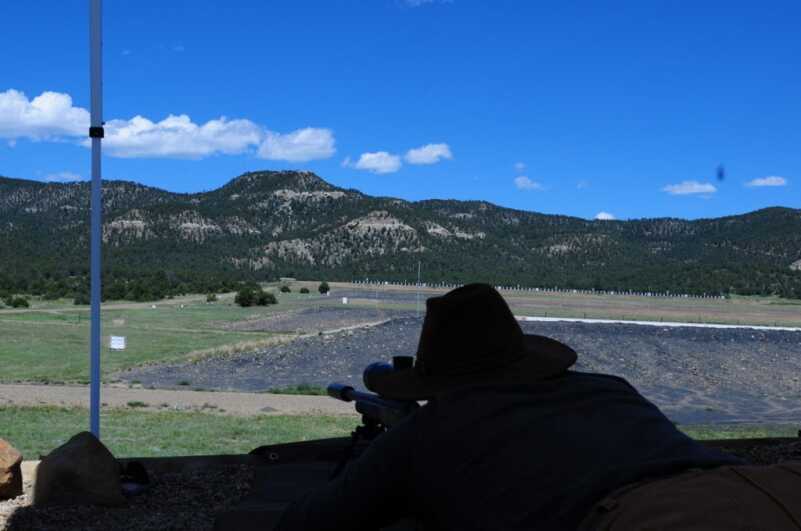
It takes hundreds of long-range rounds to develop the ballistic data and the skill to ethically hunt at long range. Here, the author shoots long range at the NRA Whittington Center in New Mexico.
DO: Know your rifle. That statement includes the whole package: rifle, scope, ammo, and ballistic data. You must know exactly where your system shoots at every distance. If you want to make lethal hits at long range nothing can be left to chance.
DON’T: Trust that someone else’s dope will work for you. Every person’s eye, cheek weld, body tension level, trigger squeeze is different. You’ve got to verify the zero as well as the ballistic data on a rifle before you hunt with it.

The spotter’s job is important – his responsibility is to read the animal, make a wind call, and spot vapor trail and impact.
DO: Always hunt with a spotter. No matter how good you are, never take long shots without an experienced buddy spotting for you. He’ll read the wind, give you heads up on any changing conditions, and call your impact and correction for a follow-up shot, if necessary.
DON’T: Shoot without permission. Make sure your spotter has his eye in the scope and is expecting you to shoot. A quiet “Ready” or “Send it” from the spotter will give you the green light. Establish communication protocol during practice sessions, so you both know what to expect.

Windy conditions make hitting a long-range target difficult – especially one like this 1,800-yard steel plate. That’s over a mile, and though the author hit it a few times, he missed some too.
DO: Get a perfect range reading. Often it’s very hard to get the exact range to your quarry. Laser nearby rocks, trees, and other animals to verify your read to your target. Even a 20-yard misread at an extended distance can mean the difference between a hit and a miss.
DON’T: Shoot in high wind. Even if you’re really good at reading wind, be very cautious about sending a shot at an animal through it. Try this: next time you experience 20-plus mph gusty wind conditions, go out shooting. If you can hit a 12-inch deer-sized vital area every shot at, say, 750 yards, you belong on an Olympic shooting team, not hunting deer.
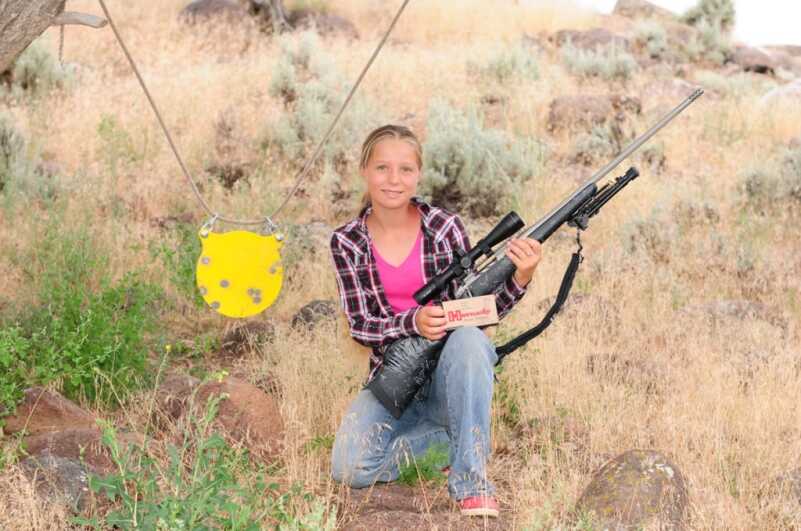
Vital-sized steel plates give good feedback. If you can hit it every shot, you’re good to hunt out to that distance. If you miss a shot here and there, keep practicing.
DO: Be aware of your projectile’s limitations. For example, the 6.5mm 143-grain Hornady ELD-X bullet (one of my favorites) is advertised to expand at velocities down to around 1,800 fps. Shot from a 6.5 Creedmoor at my home elevation of 6400 feet, that occurs somewhere between 800 and 900 yards. Beyond that, the bullet won’t open reliably or kill cleanly.
DON’T: Take a chancy shot just because it “might work”. There are no excuses for taking shots that are too far or too windy or a bad angle or anything else of that nature, just because there is a chance it will work out and you will have awesome bragging rights. That kind of behavior is unethical.

The product of a good long-range setup; the author’s wife made a very challenging shot in tough conditions to harvest this nice muley.
DO: Get perfectly steady. Establish the best position you possibly can before making the shot. If you can’t keep the crosshairs inside the vital zone, adjust your position until you can. Only then should you take the shot.
DON’T: Take your gun off an animal that drops in its tracks. If you’ve hit him high – just above the spine – he might drop like he was hit by a train, only to get up and march away when the shock wears off. Keep your crosshairs on the animal until you’re absolutely sure he’s dead.

The author watched this good buck drop through his scope. Keeping your scope turned down will enable you to spot your hit, stay with the animal, and watch it go down.
DO: Turn your scope DOWN. That’s right, I said down. Scopes with magnification big enough to read the morning paper from a half-mile away are all the rage. But for hunting, they are a handicap. Out to 500 yards, nine or ten power is ideal and will enable you to spot your impact; assuming you do everything else right. Even at 800-plus yards, anything over 18 power is too much. Spotting your hit, and keeping the animal in your scope to watch him drop or make a fast follow-up shot is far more important than counting his eyelashes.

In the author’s opinion, an ethical hunter will always strive to get as close as he can before shooting. He stalked across table-flat terrain over a mile and three hours to make one perfect 486 yard shot on this nice pronghorn.
CONCLUSION
Early in this article, I stated that “600 yards is the new 300”. With the right equipment, training, and experience, it’s true. That said, six-hundred is, in my opinion, the maximum distance most well-trained hunters should shoot at living animals – just as 300 used to be. Most hunters simply don’t have the ability to put every shot into the vitals beyond that, even with extensive practice. To my point, consider this; I shoot and hunt for a living. I believe I could – with the right rifle – cleanly harvest an animal beyond 600 yards. But I still try to get close, and to date, my furthest shot on an animal was exactly 586 yards.


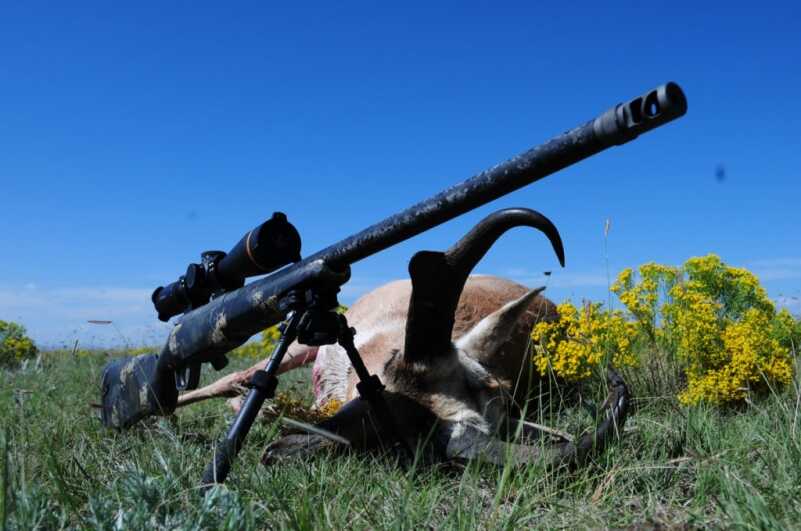
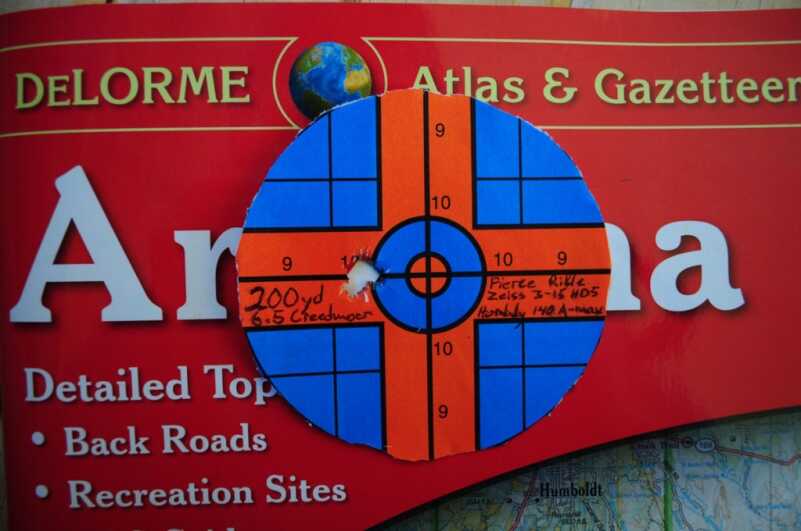
Can you try not calling firearms weapons. I hunt and my rifle, shotgun, or handgun is a firearm. I don’t particularly care to think of my firearm as a weapon, although it could very well be used as one. Imagine the big game armed and ready to return fire, then, we have the need for a weapon. Just a thought. Thank You.
Really good article, but I dont know about what you stated about the old 30-06 and scope. A lot of those old vets from WWII used to take out the enemy at 800-1000 yards with a M1 Garand and iron sights. The ‘ethics’ of long range hunting!? Well, it is America. People don’t always believe like you, even if you believe your valid points, and, I guess it depends on need. IF that was dinner for the family, or go hungry, you just nigh take any shot. It’s not religion, it’s perspective, or scenario, isn’t it?
The difference between shooting an animal and an enemy is that you want a clean quick kill on the animal but with an enemy you just want him DOWN, if it’s a wounding shot that’s the better, he becomes a liability to his army and with any luck you could get a few more of his buddies when they show up.
I commend those people that practice with their rifles to be proficient so they can shoot at 1000 yards but the part of hunting is the challenge of pitting your skills against the skills of your prey. Long range shooting does non of that in fact my opinion is that it is outside of the boundaries of fair chase. I shoot about 150 rounds a month which is far grater than the vast majority of hunters and have done that for the last 50 years. I live in North Dakota were a calm day occurs about once a year. I have shot prairie dogs out to 400 yards where a five mile cross wind will cause a miss of about 8 inches with a rifle that shoots a bullet at 3800 ft per second so the chances of a wounded deer increases many fold. Shooting a Deer at 900 yards is not hunting, its just shooting a deer.
Dwight, I’m 67 and want to hunt with you. I could not agree with you more. Nice to hear about true sportsmanship. Good luck in the future
I am from The northeast and grew up hunting with 100 yards being considered a long shot . During my time in the military I had the chance to hunt all over the United States. I’ve seen my share of long range hunters and quite frankly most leave a lot to be desired . My western caliber of choice has been the 270 Winchester and the 30-06. I have never felt under gunned with those . I also hunted Washington state with a Winchester model 94 in 30/30 for deer and elk with success. Honestly I always keep my shots under 350 with the 270 and 30-06. 90% of my shots have been 125 and under. That being said if you like that sort of thing make damn sure you can shoot . Tracking a wounded deer is hard at 125 let alone 1000
Coyotes at 300 yards and some at more than 400 yards have fallen to me but I would not shoot at a deer at that range.
When I miss a coyote, it is merely PETA approved hazing. If it is wounded and hobbles away, I regret it. Even though coyotes are apex predators here and a threat to our calves, I don’t like any animal to suffer. When I drop one and take its picture with the rifle, it’s very satisfying.
This is just wrong. The guy missed on the first shot, DUH!!!!!
I find it interesting with all the do’s and dont’s, which I agree with, that the authors own admission the shooter missed with the first shot. What would have ensued had it not been a clean miss. Animal now wounded, what is the likelihood that this animal ends up recovered. I’d say much less likely than if the shot had been made at 300.
I know that I’m proposing a hypothetical and I’ve been rebuffed many times by fans on long range hunting because of the use of the hypothetical. Does not change the fact that same shooter at 300 would likely have made that shot 100% of the time with little to no risk of an non fatal or worse fatal but not immediately so wound.
I grew up hunting the west and still do. I regularly bang steal at distances out past 1k. I’m proficient with my equipment and reading the environment. The idea of shooting at game animals past about 400 really shouldn’t be done. More work should be put into getting close. If you just can’t that day under those conditions. It just wasn’t your day!
For every modern sporting cartridge 400 yards is about where the margin for error begins its exponential difficulty curve. This point can’t be argued logically. It’s the point at which the amount of dope required outstrips the amount of the animals vital areas. Just because you can doesn’t mean that you should.
I know how easy it will be for proponents of this hunting trend to dismiss what I have to say. I’m old, which I’m not, I don’t know what I’m talking about, which I do, I’m just being a na sayer because I don’t like change and the list could go on and on for ever. It’s always easy to justify owns thoughts and actions especially when they’re backed up by this trend.
There is good info in this article but back to my original point. The shooter missed the first shot. Luckily it was a clean miss. That doesn’t coincide with his own list of dos and donts. Make the shot 100% of the time or don’t take it.
Hear, hear !!!
Spot-on comment by Pat, and I hope folks who read this article also read his excellent rebuttal comment.
Shots at game animals at the ranges discussed in the article are both unethical and unnecessary, at least for anyone with halfway decent hunting skills. Better to work on the hunting skills and get within 300 – 350 yards, versus risking the indiscriminate wounded of animals at 500 yards or more. The animals deserve better treatment than that at our hands. Let’s have respect for the game animals, and save the long range stuff for the rifle range, and paper and steel targets.
Aram, it\’s very nice to see an article like this focusing on the ethics of long range hunting. I have been (sorta) joking for the last few years that everyone thinks they are Chris Kyle with the excellent rifles, optics, and ammo available nowadays. I\’ve seen people wounding more animals in the last decade than at any point in my 40+ years of hunting. I don\’t get around as much as a serious hunter like yourself, so I don\’t know whether this is anecdotal or widespread. But I hunt in Idaho, Utah, Montana, and Alaska. It is definitely a problem in those western locales. Even though I punched 5 in 5\” at 1120 yards with my 6.5 Creedmoor (once, my all-time best) I have never taken a deer or elk at beyond 300 yards. Like an old Montana hunting guide told me, \”beyond 300 yards you are no longer hunting, you\’re just shooting\”. With today\’s gear that distance may have grown longer but the point is still valid.P.S. Who makes the barrel with the hooded front sight shown in the picture with the square plate at 1800 yards?
Best Piece I’ve ever read on honest, reasonably objective, ethical hunting and necessary tactical guidelines. Something, unfortunately, that is usually noticeably absent in today’s voracious, almost rabid, predatory sport hunting environment,
I originally received my sniper training during a short 3 week OJT trial development program back in the day during the Vietnam debacle. Then later expanded my ‘experience’ and knowledge to Big city SWAT units which began to proliferate around that time. Of course we had nothing like the equipment today. And consistent thousand yard hits with anything less than a .50 BMG were almost legendary, but in my line of private contracting and personal executive security work I had clients who were ‘big hunters’ and mixed business with sport so I was along on many hunts. Invariably, they all took ‘unethical’ shots that usually crippled the animal just enough to have it run off unrecoverable to die slowly in fear and pain in some underbrush. My rather stern criticism directly to these clients sometimes, indeed, cost me the gig. I guess I got ‘conditioned’ somehow from having an appreciation of animals and the experience of hunting armed humans that I never developed the remotest desire for hunting animals. I have several on my hobby farm. But even if I did hunt, with my experience and skill level I’d still never take the shots that some of these rank amateurs always attempt as the article implies. Not because I don’t know how, but if you are Not WELL PRACTICED to a ‘consistency’ hit percentage, at certain ranges, It will be way more likely that you will miss the shot than hit it when you factor in the stress of the actual live shot during a hunt. And this ‘miss factor’ likelihood increases proportionally as distance increases. I’ve never seen it fail to happen in countless LD shot attempts. You can give me a 6.5 C with a 1/2″MOA and a 3k scope and I still won’t take a shot today at a live, even slightly moving target over 500 meters in a direct 10kt x-wind unless I absolutely know I could do it 98% of the time, ALL the time. Which would mean I would have to be maintaining at least a weekly practice session under those conditions. Which I don’t at this point in my life schedule. My maintenance practice now is only CQB work. So my LR consistency percentages due to lace of practice would be too low at 400m plus to guarantee a likely hit under wind conditions instead of a likely miss. So why would anybody in their right mind who was not a closet sociopath or some other kind of ‘personality’ who gets ‘high’ on killing defenseless creatures who are not imminently attempting to kill them or other people for no humanly necessary reason, be out there taking these way out fantasy shots that won’t even hit the poor beast most of the time? I really don’t know anymore. Maybe there’s no such thing anymore as ‘ethics’. (Certainly evident in politics?)
But they should at least study and memorize this excellent article.
Good, ethical advise. In my neck of the woods there are numerous hunters carrying .338 Lapua Magnum hunting rifles that shoot great. At 100-500 yds. where our local range stops. I have offered many times to take these hunters to a 1000 yd. range to practice and not one takes me up on it. Instead they range a rock across a canyon at somewhere near 1000 yds., shot it a number of times (after finally dialing in windage). Looked at their splatter of shots on the rock and declare the group a 6-8″ ‘kill’ and go home. The fact that the rock in question was quite a bit larger than they imagined and the group more like 30″ when actually measured doesn’t faze them as they never make their way to the target and actually measure it. Then they can not understand why they can not make a hit at 800 yds. on opening day.